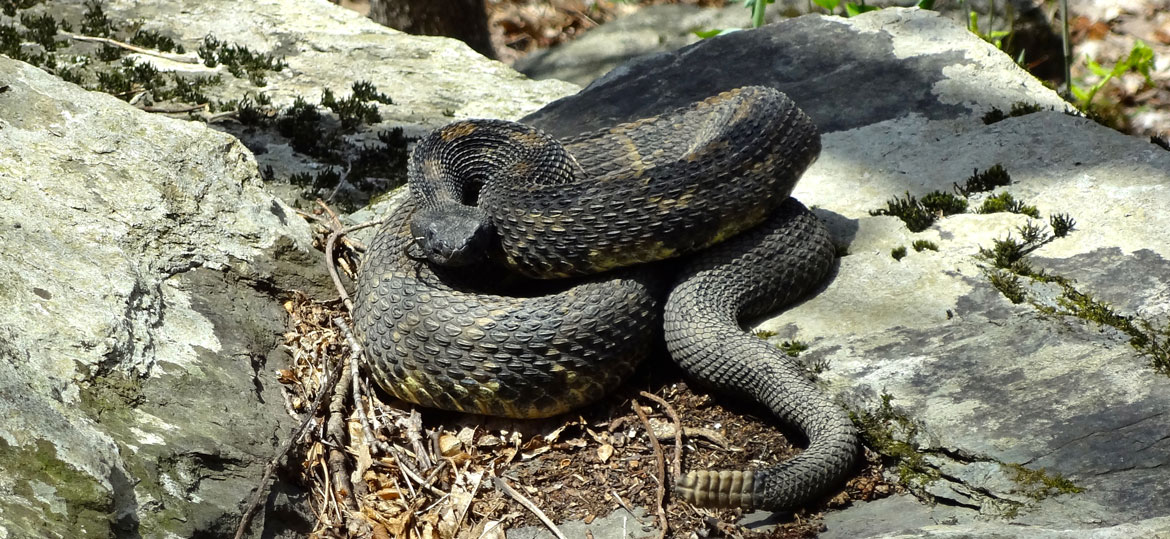
The Timber Rattlesnake (Crotalus horridus) was named by Linneaus in 1758, and the genus name, Crotalus, literally means "hollow in the rocks" after the denning habit the Timber Rattlesnake uses.
Timber Rattlesnakes were bountied in Vermont until 1971, and designated endangered in 1987. They have a triangular shaped head to accommodate venom glands and injecting apparatus.
Habitat
Timber Rattlesnakes are found primarily in temperate forests throughout the eastern United States. They range from northern Florida to eastern Texas north to Wisconsin and New Hampshire, but are absent from Michigan. Historically they inhabited southeastern Ontario and southern Maine, but populations there thought to be extirpated.
In Vermont they inhabit rock slides, ledges, and nearby woodlands.
Reproduction
Timber Rattlesnakes are a "K" selected species, which is characterized by a long life span (20-25 years, 35 years in captivity), late maturation, low reproductive output, and slow turnover in population.
Female timber rattlesnakes reach sexual maturity between six to 11 years old, and males between four to seven years old. At maturity, they have litters of four to ten (average of eight) young every three, four, or five years thereafter. Adult females may only have three to five reproduction events in a lifetime.
Breeding in late July, August and September, after annual shed (June 15-July 1) at this point females release pheromones - males start searching for them. Female will store sperm throughout the winter and in late May the sperm are released - fertilization occurs.
Gestation generally take 90 days during which gravid female does not usually eat. As a result they may lose an average of 40% of their body weight at parturition. Birthing dates range from August 15 to September 25.
Timber rattlesnakes bear live young. Young are wrapped in a choriallantoic membrane - after a few minutes the young start moving, poking to get out of membrane.
The mother stays with young between a few hours to several days after neonates first shed (approx. 10 days). This is the only snake species to exhibit any maternal care. Young are precocial - able to care for themselves immediately. The young follow the adult's pheromone trail back to den site.
Diet
They eat mostly mice, voles, chipmunks, cottontail rabbits, squirrels, and shrews.
Timber Rattlesnakes are ambush, "sit and wait" hunters. Using its vomeronasal organs and tongue, the snake follows its injected prey. When found, the snake consumes the animal head first.
Occasionally takes birds (7%), reptiles (1%), and amphibians (0.3%).
Snakes will occasionally seek out prey by following a scent trail. The smell of decaying animal (carrion) is an attractant.
Management
Currently, the Vermont Fish & Wildlife Department is conducting a Vermont Rattlesnake Research Study. The study includes the following partnering organizations:
- The Orianne Society
- The Nature Conservancy
The study's objectives are to:
- Map critical habitats;
- Gaininsights on population dynamics/ genetics; and,
- Provide outreach and education to foster tolerance/acceptance for the species.
More Resources
- Vermont’s Rattlesnake Response Program is a FREE service that aims to protect Vermont residents and Timber Rattlesnakes by safely moving nuisance rattlesnakes away from private and public property.
- VT Rattlesnake Research Video - Featuring Fish & Wildlife biologist Doug Blodgett capturing a timber rattlesnake as part of ongoing research on snake fungal disease in Vermont.
Endangered in Vermont
The timber rattlesnake is a rare species, and has been designated a Species of Greatest Conservation Need (high priority) in Vermont's Wildlife Action Plan and is endangered in Vermont. Please report all sightings of this species in Vermont. Take photos if possible. Even historic sighting information is useful.
Read the Vermont Timber Rattlesnake Recovery Plan
